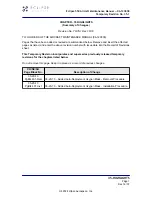
Skyranger Swift Operators Manual (issue 3)
21
5.
Performance
5.1 Introduction
The following data was obtained in the original UK prototype. Changes
from this data for your particular aircraft will be at Annex A. When
using the data for planning purposes, apply sensible safety factors,
such as are contained in CAA Safety Sense leaflet 7C (aircraft
performance), part of which is reproduced here by kind permission of
the CAA.
5.2 Climb
Speed for best rate of climb is 57kn CAS [
IAS]. Best angle of
climb speed (Vx) is 48kn CAS [ IAS] When selecting a climb
speed, always remember that should anything go wrong, more speed
gives you more time to sort your problems out. Although climb
performance may change between aircraft, the best climb speeds
should not vary significantly. Specific performance figures for your
aircraft will be in Annex A.
5.3 Glide
Speed for best glide angle is 52kn CAS [
IAS], at which a glide
ratio of around 9 to 1 may be expected. Flying a little slower at 47kn
CAS [ IAS] will give the minimum descent rate (min sink) of
around 550FPM.
5.4 Cruise
Because microlight aircraft are very strongly affected by weight, engine
condition, propeller matching, wind and air temperature, it is very hard
to give any reliable information concerning the cruise performance of
the Skyranger Swift. The pilot is encouraged to plan very
conservatively until sufficient experience is gained of the fuel
consumption and cruising speeds at the conditions in which the
aircraft is normally flown.
Summary of Contents for Skyranger Swift
Page 2: ...Skyranger Swift Operators Manual issue 3 2...
Page 46: ...Skyranger Swift Operators Manual issue 3 46...
Page 48: ...Skyranger Swift Operators Manual issue 3 48...
Page 50: ...Skyranger Swift Operators Manual issue 3 50...
Page 52: ...Skyranger Swift Operators Manual issue 3 52...
















































